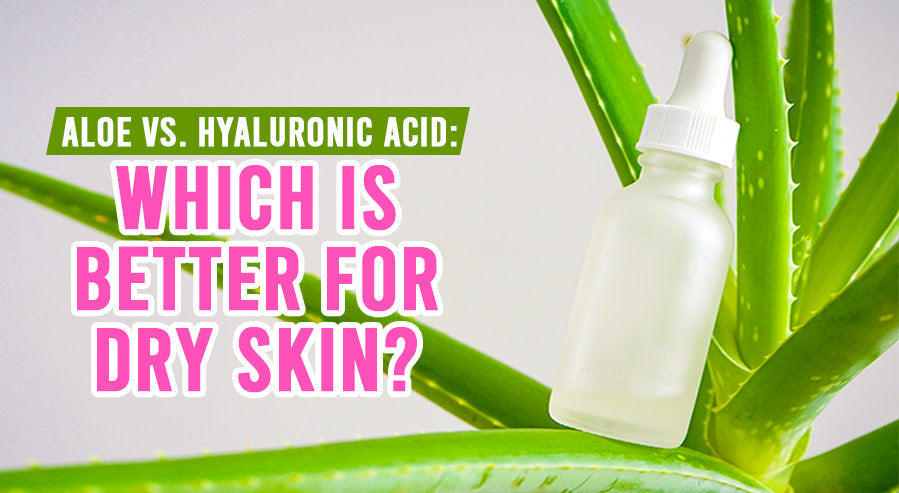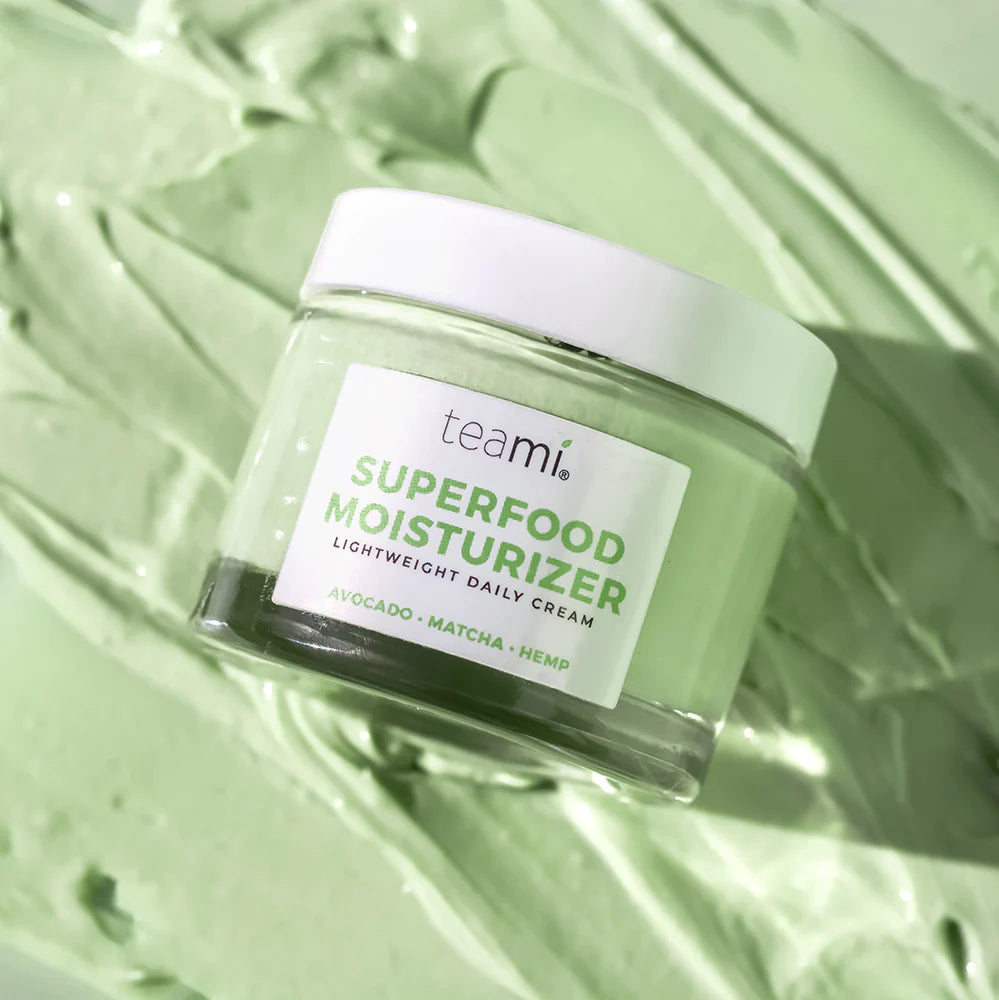Aloe vs. Hyaluronic Acid: Which Is Better for Dry Skin?

When you live in a dry climate, it usually means that you can have a hard time with flaky and dehydrated skin, which can make you feel uncomfortable. You have two natural hydrators to choose from - aloe vera and hyaluronic acid! Each one works in its own way to help relax and nourish your skin.
These ingredients might even change your general skincare schedule in ways you hadn't thought about before. When you pick the right ingredient for you, it can become a big part of how you take care of your skin day in and day out. I want you to see how each ingredient works to hydrate and relax your skin. You should know what matters to you the most when you choose to use them. Your skin type, the local climate, and the way you apply your products all play a role in picking which option works best with your preferences.
Let's get started so you'll find which ingredient is a better fit for dry skin!
Hydration Mechanisms
When you keep your skin hydrated, it all starts with aloe vera and hyaluronic acid. You can get these two natural ingredients working in a few different ways! First, aloe vera is like a water bottle for your skin since the plant is about 98% water. It contains a gel-like substance with some compounds that act like little sponges when they hold the moisture right where you need it.
Next, you should think of hyaluronic acid as a magnet for water and moisture. It pulls water in and can hold as much as 1,000 times its weight in water. This makes it great at drawing the moisture from the air into your skin. But you should try to use it on damp skin. In a dry environment, it might pull some water out from deeper layers of your skin instead of from the air.

When you apply hyaluronic acid, you can put it on slightly wet skin. Then, follow up with a moisturizer to lock in the moisture where you want it most. Aloe vera is forgiving, and you can use it anywhere and at any time because it contains its own water content. This makes it not as dependent on the environment.
These natural ingredients also give you some extra uses. Aloe vera helps balance the skin's pH and even speeds up healing, while hyaluronic acid can give your skin a plumper and fresher look. When you see your local climate, you might end up liking one over the other. In a dry or desert-like setting, aloe vera can work reliably. In a more humid area, hyaluronic acid often works way better.
Skin Compatibility
Let me tell you about my friend Abbie, who battled with eczema for years and tried almost every remedy until she finally found aloe vera. It completely changed her entire skincare schedule! Her experience helps you see that different ingredients can work in different ways for different skin types.
You might find that if your skin is more sensitive and tends to respond to even the slightest irritation, aloe vera could be the natural ingredient you need. It mixes well with water and acts very gently on irritated areas. Think of it as nature's own relaxing remedy for your entire face - especially when you want to manage redness or any inflammation.

You can also learn that hyaluronic acid behaves like a supportive friend, someone who adjusts based on your surroundings. In a humid environment, it pulls the moisture from the air directly into your skin, giving it that fresh and plump look. But in a dry climate, it can sometimes draw moisture out instead - it'll make your skin feel even drier than it did before.
You have to take into account that the climate matters more than you might expect when you're picking between these two ingredients. Aloe vera works its relaxing magic regardless of if you're in a desert or a rainforest. It's almost like carrying a little built-in reservoir of moisture along with you wherever you go.
You'll also find that aloe vera can help cut back on problems like acne and sunburns. It can even help with those persistent little red bumps that come from having sensitive skin. I've even seen people with challenging skin use it successfully without any real problems. You should also know that hyaluronic acid is great at plumping up your skin and keeping it looking fresh. But you do need to make sure to use it correctly.
You might even find that you benefit from these two ingredients together. Just think of aloe vera as the base moisturizer and hyaluronic acid as the extra magnet that helps to draw in more moisture. Together, they help your skin and keep it balanced and hydrated throughout the day.
Additional Benefits
You can treat your skin to the very best that nature has to give to you with aloe vera and hyaluronic acid. Your skin receives some nourishing help that supports its natural balance! Aloe vera comes in handy when too much sun leaves your skin feeling burned. You can find quick and cool relief because its natural compounds help to calm inflammation and speed up healing. Think of it as a gentle and relaxing hug for your irritated skin.
Hyaluronic acid works in a different way - you get some added hydration. It has the ability to hold water - imagine a small sponge that soaks up water as much as 1,000 times its own weight. That's what happens on your skin. You get a nearly invisible layer of moisture that helps to smooth out fine lines.

You can also use aloe vera on small cuts, scrapes, or breakouts. It feels relaxing on your face, body, or even your scalp when you need some relief from dandruff. At the same time, hyaluronic acid works together with your skin to plump it up and can help to soften wrinkles. Imagine filling up a deflated balloon with water - that's how your skin can seem firm and bouncy again!
You can see that these ingredients behave differently depending on the weather. Aloe vera gives a light hydration that feels just right in humid locations without making your skin feel heavy.
You can use hyaluronic acid all year round, and it works best when the air has a bit of moisture. You might see some clear results, too. Aloe vera can cool down irritation almost immediately and helps to cut back on redness. Hyaluronic acid can give your skin a plumping effect, leaving it softer and dewier as soon as you apply it.
Possible Drawbacks
You need to know that even popular ingredients like hyaluronic acid and aloe vera can sometimes actually work against you when you're trying to treat your dry skin. Hyaluronic acid gets praise for helping to hydrate the skin! But it actually needs to have the right conditions to work as well as you might hope. In a dry area, it can pull moisture from deeper within your skin instead of drawing it from the surrounding air.
You also need to realize that hyaluronic acid on its own won't keep your skin hydrated for very long. You have to use it with some other moisturizing ingredients to help lock in the water - like filling up a water balloon and then tying it off to keep the water inside.

Aloe vera comes with its own set of challenges that you need to be aware of. Even though people like its relaxing effects, your skin might not always get along with aloe vera. You might experience some itching when you try it or even a rash if you have a sensitivity to it. When you have any cuts or open wounds, you should be extra careful - because aloe vera may impede your skin's healing process - especially if you use it fresh from the plant.
Using these ingredients correctly can help to keep your skin healthy. You need to apply hyaluronic acid to damp skin and immediately follow up with a moisturizer - or else your skin could end up feeling even drier than it did before. You also have to watch the amount that you use. Too much hyaluronic acid can leave your skin feeling heavy and sticky. Overusing aloe vera may cause irritation or some unexpected reaction when your skin isn't used to it.
Remember that adding more products to your skincare schedule doesn't automatically create better results. You might think that some extra hyaluronic acid or regular applications of aloe vera throughout the day will fix your dry skin. But that strategy doesn't produce the expected results. Take the time to find out what your skin actually needs, and then use these ingredients wisely.
Application Tips
When you play around with these ingredients, the little facts can help you out! I learned this the hard way after I slathered some hyaluronic acid on my dry skin. I ended up with a face that actually felt tight and dehydrated. You have to use it while your skin is still a bit wet after washing so it can do its job.
You might expect aloe vera and hyaluronic acid to work in the same way - but that's not actually the case. Each one has something a little different to give you. Just to give you an example, hyaluronic acid needs moisture nearby to stay active (like how a sponge needs water to keep its shape). Without enough dampness, hyaluronic acid can actually pull water out from the deeper layers of your skin.
Aloe vera feels a bit easier for you to use. You can put it on dry patches whenever they start to bother you, and you can even use it as an overnight treatment.

You also want to keep in mind that layering your ingredients does matter. After you apply hyaluronic acid to your damp skin, you should make sure that you follow it up with some moisturizer to lock everything in. If you skip that last part, you might end up with skin that feels even drier than before.
You should also think about how the weather might change how some items work. In dry climates, hyaluronic acid might not work as well because there isn't enough moisture in the air. In that situation, running a humidifier can help. Aloe vera works.
It doesn't matter if you're in a desert or somewhere tropical, as it has relaxing effects. The time of morning or night could also change how these ingredients work for you. When you add hyaluronic acid to your morning schedule, it helps keep your skin hydrated throughout the day. Aloe vera at night can give your skin lots of time to soak up its effects while you sleep.
Alternatives And Combinations
You might feel like you have to choose between aloe and hyaluronic acid. But you can actually use them together for even more effects.
When you combine them, they work as a team to keep your skin hydrated and comfortable and can give you effects beyond what a single ingredient can give you. Picture hyaluronic acid as a moisture magnet that draws water from the air and helps your skin hold onto it. Aloe acts as the relaxing partner that brings some extra hydration and soothes any redness or irritation you might feel.
You can see that products already combine these two ingredients, which makes your schedule very easy. You also have the option to apply them separately in your skincare schedule. Always put the hyaluronic acid on your damp skin first so it can hold in that moisture. If you like experimenting, try mixing a little pure aloe gel into your regular hyaluronic acid serum.
This DIY strategy saves you money and can give you some control over how each ingredient might work for your skin. You can adjust the combination until it seems like a better fit for you. You might find that one ingredient isn't a match for your skin or budget, so other options are available.
Natural options like glycerin can have some effects that are similar to those of hyaluronic acid. Plant-based oils like jojoba or avocado oil might calm your skin, just like aloe.

At times, you might even feel that hyaluronic acid leaves your skin feeling drier - more common when you live in a place with low humidity. In these cases, adding aloe to your schedule can help. Aloe can give you some quick relief, while hyaluronic acid works on a deeper level to give you more long-term hydration. Remember that every person's skin is different, so what works for someone else might not work for you.
You might need to try different combinations or amounts to find what feels right to you. How your skin responds helps you build a schedule that works for you.
Finding The Perfect Blend
Every ingredient has its own purpose, and it makes it easy for you to find the right combination for your skin. You might love the relaxing and cool feel of aloe vera. You might also like the deep hydration that hyaluronic acid brings to your schedule. You can now choose from a few different options.
Check what your skin needs each day. It might wake up feeling tight and dry, so you could try a serum with hyaluronic acid to add some moisture. Your skin might sometimes seem red and irritated during the day. This makes aloe vera gel the perfect choice to help calm and cool it down. Together, these ingredients work well, and they allow you to combine them in any way that fits your preferences. You have the freedom to experiment until you find the right balance that makes your skin feel comfortable.

At Teami, we create teas that help you sleep well, stay healthy, and feel good each day. Our natural skin products can brighten your complexion and give you that healthy and radiant look you have been wanting. You're welcome to drop by our store and try something new. When you treat your body right, it shows in every detail of your life.
Subscribe to our Newsletter
Subscribe to our newsletter and get 10% off your first purchase
 Instagram
Instagram



